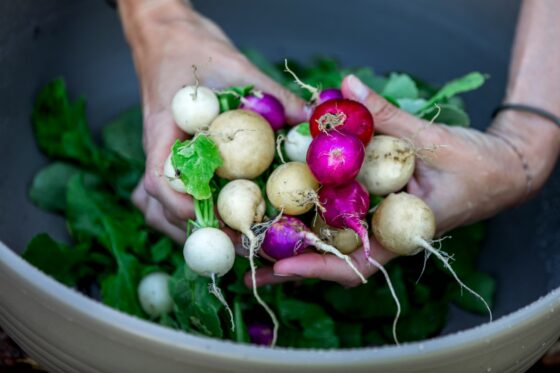Radish: leaves, flower & harvest time
Radishes are at the top of the menu in summer and are very easy to grow in the garden. Discover what radish leaves and flowers look like and how to care for radish plants.

Radish (Raphanus raphanistrum subsp. sativus) is one of our favourite summer vegetables. Botanically, the radish belongs to the Brassicaceae family which includes broccoli, cauliflower and kohlrabi.
Contents
Radish profile: origin, radish growth and characteristics
This delicious, slightly spicy root vegetable is well known in the UK, although it has not been around for very long. Originally from Asia, the radish only found its way to Europe in the 16th century. Because they grow so fast (radishes take just 4 to 8 weeks to form, depending on the variety and season), these crunchy sprouts are often grown at home as an early or late crop, or between other vegetables. What is more, radishes also grow well in pots on a patio or balcony.
Depending on the variety, radishes are either spherical, or elongated and conical. Radish varieties also differ in colour, taste and optimal growing season. Have a read of our article on radish varieties to discover your favourite!

Depending on the temperature and weather, radish seeds germinate within a few days to a week after sowing. Above the soil, they sprout with two heart-shaped leaves, called cotyledons. Meanwhile, under the surface, radishes develop a taproot, which receives sugars from the photosynthesising leaves. It is these sugars that force radish roots to swell into crunchy, healthy tubers.
After this vegetative growth phase, the radish plant enters a generative growth phase. This is when the plant bolts and forms seeds for reproduction. During this generative phase, the radish roots become hard and inedible. So, unless you are aiming to save seeds, keep a close eye on the radishes and harvest them before they begin to bolt!

Radish leaves
After the first two cotyledons form, several dark green, slightly hairy leaves develop with irregularly serrated edges. These leaves emerge from the shoot on thin petioles. Radish leaves are edible and packed with mustard oils. So instead of throwing away radish leaves, why not use them in a spicy pesto or tasty soup!
Radish flowers
If it is too hot and dry during the growing season, or if they are not harvested in time, radishes go to seed and form countless white to pink, cross-shaped flowers. From this point on, the radish is inedible. However, insects, like bees and butterflies still find plenty of food in radish flowers. What is more, after flowering, 3 to 4cm long green pods will develop on the plants. When fresh, these crunchy, green radish pods are edible for humans too.

With a little patience, you can wait until the pods have dried, before opening them up, and harvesting the ripe seeds, ready for next year’s crop. In fact, even if the gardening year is over, you can sow these seeds indoors on the windowsill and harvest mildly pungent radish microgreens after a few days.
Propagating radishes: radish seeds & more
Radishes can be cultivated in a veg patch and in pots on a balcony or terrace. Read our article on planting radishes to find out exactly how to sow radish seeds.
Radish care
Radishes are a very low-maintenance crop, and do not require any special care, aside from a regular water supply. Occasionally, it is a good idea to aerate the earth by removing weeds and loosening the soil around the plants. But even without these measures, radishes still thrive.
Tip: Avoid planting radishes in between other brassicas like cabbage, daikon or horseradish. It is also best not to plant your radish in the same area several times in a row, as this can lead to diseases.
Radish seedling: do you have to prick out radishes?
You can either sow your radish seeds individually, and provide them with enough space to grow in advance, or sprinkle the seeds directly onto the soil. Although this second method sounds easier, you will eventually have to thin out the plants. This process, called pricking out, involves carefully removing individual radish seedlings from the soil after they germinate, and replanting them elsewhere, in a pot or garden bed so that they have room to develop.

Watering radishes
So that the seeds can germinate and develop large, round roots, your radishes will need plenty of water, especially when they are young. When watering radishes, be sure to use a rose head sprinkler.
Fertilising radishes
Before sowing your radishes, enrich the soil with a natural fertiliser, such as our Plantura All Purpose Plant Food, or some compost. This will provide your crop with enough nutrients for them to grow for the some time.

- Perfect for a variety of plants in the garden & on the balcony
- Promotes healthy plant growth & an active soil life
- Long-lasting fertiliser that is free from animal products - child & pet friendly
Harvesting radishes
When are radishes ready to harvest? Radishes are ready to pick when the round, red roots are slightly smaller than a ping-pong ball. You can also harvest slightly smaller radishes, which are still tender and delicious. As the radishes get larger, they become woody and eventually inedible.

When can you harvest radishes?
Depending on the season, radishes take about four to eight weeks to reach harvest maturity. If you have sown radishes in rows, start your harvest early, when the tubers are still small. Otherwise you may struggle to harvest and eat them all before it is too late. When left to grow for too long, very large radishes become woody, and the outside of the flesh becomes tough and stringy.
How do you harvest radishes?
When harvesting your crop, grasp the radish shoots just above the root and pull the plant out of the soil. Be careful not to damage the red roots as this will significantly reduce their shelf life.
Storing and preserving radishes
Once harvested, you can store radishes in the fridge for a few days. To do this, remove the foliage, as this draws water from the roots, and wrap the root in a damp kitchen towel.
You can also freeze fresh radishes after washing and removing the foliage, but this usually causes the vegetable to lose its crunchiness and flavour. Alternatively, you can preserve radishes for longer by slicing them up and pickling them in vinegar.

Radish nutrition and ways to use them
With less than 15kcal per 100g, this root vegetable is very low in calories – perfect if you are on a diet! Radishes are also full of fibre, so you will not be left feeling hungry. They contain vitamin C, small amounts of vitamin B/B9 and a balance of minerals, including potassium, magnesium, calcium and iron.
As well as vitamins and minerals, radishes contain plenty of mustard oils (mustard oil glycosides), which is what gives this vegetable its spicy flavour. Mustard oils are said to have antibacterial, antifungal and positive digestive effects.
Crunchy radish is usually eaten raw: as a quick snack between meals, in salads or as a colourful side dish. However, they are also delicious in soups, pan fried and oven roasted.
Radish pests and diseases
Radish plants can be attacked by many brassica pests and diseases. These include cabbage fly, flea beetle and cabbage white butterfly. There are also two fungal diseases that cause the radish problems: club root, which causes swollen, distorted roots; and radish black root disease, which turns a radish black from the outside. If your plants are suffering from either of these diseases, dispose your plants in general waste and avoid growing brassica plants in that location again for at least 4 to 5 years.
If you are interested in growing your own radishes in the garden or on the balcony, read our article dedicated to planting radishes for our top tips.





















